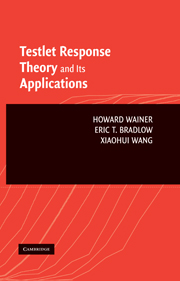Book contents
- Frontmatter
- Contents
- Preface
- PART I INTRODUCTION TO TESTLETS
- PART II BAYESIAN TESTLET RESPONSE THEORY
- PART III TWO APPLICATIONS AND A TUTORIAL
- 13 Using posterior distributions to evaluate passing scores: the PPoP curve
- 14 A Bayesian method for studying DIF: a cautionary tale filled with surprises and delights
- 15 A Bayesian primer
- Glossary of terms
- Epilogue
- Bibliography
- Author Index
- Subject Index
13 - Using posterior distributions to evaluate passing scores: the PPoP curve
Published online by Cambridge University Press: 08 January 2010
- Frontmatter
- Contents
- Preface
- PART I INTRODUCTION TO TESTLETS
- PART II BAYESIAN TESTLET RESPONSE THEORY
- PART III TWO APPLICATIONS AND A TUTORIAL
- 13 Using posterior distributions to evaluate passing scores: the PPoP curve
- 14 A Bayesian method for studying DIF: a cautionary tale filled with surprises and delights
- 15 A Bayesian primer
- Glossary of terms
- Epilogue
- Bibliography
- Author Index
- Subject Index
Summary
Introduction
The goal of this chapter is two-fold. We want to provide an evocative example of how to use the posterior distributions of parameters and the samples from them that are the hallmark of a Bayesian approach to model fitting while solving a practical and often vexing problem in the analysis of test data. In this chapter, we show how to evaluate the efficacy of proposed passing scores for an exam. In Chapter 14, we use the posterior distributions in quite a different context, but with equal ease.
Passing scores are usually set through some sort of judgmental procedure (e.g., Angoff, 1971). Once set, the issue immediately arises as to whether the test works well with that choice. For example, if a passing score is set well below the difficulty range of the existing pool of test items, accurate pass/fail decisions near the passing score cannot be made. It is at the passing score that the most critical decisions are made and where most of the scoring effort is placed (Bradlow & Wainer, 1998). What is needed is some way to assess how well the passing score and the test work together. The reliability of the test is a related idea but is more global. Test reliability gives us a measure of the quality of test as a whole, whereas a local measure near the set passing score is needed and is the purpose of this chapter; in fact, what we do is more general since we compute a local passing curve over the entire range of scores.
- Type
- Chapter
- Information
- Testlet Response Theory and Its Applications , pp. 207 - 218Publisher: Cambridge University PressPrint publication year: 2007



